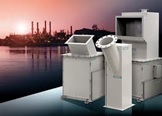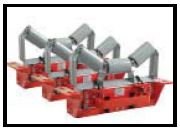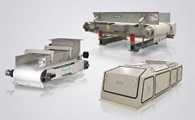|
July 2014, MARIETTA, GA
- When should one select a belt scale versus a solids flow meter versus a weighfeeder? There are several considerations in selecting the proper bulk material handling technology. How you transport the material and material characteristics can be key factors. In addition, you will want to consider what you are looking to get from your system. How important is accuracy? Do you need to control flow? How the material is transported?
Why is this important?
 Well, if a conveyor is used to transport the material a belt scale is typically the most accurate and cost-effective way to weigh bulk material as it moves through the process. If the material is not transported by conveyor, a small conveyor may be installed to allow a place for the scale. This may drive up the installation cost making a solids flow meter or weighfeeder a better option. But, there are considerations for devices, as well. For example, air movement though a solids flow meter will adversely affect the performance of the meter so a rotary air lock maybe required to prevent air movement if the system has dust collection system. Well, if a conveyor is used to transport the material a belt scale is typically the most accurate and cost-effective way to weigh bulk material as it moves through the process. If the material is not transported by conveyor, a small conveyor may be installed to allow a place for the scale. This may drive up the installation cost making a solids flow meter or weighfeeder a better option. But, there are considerations for devices, as well. For example, air movement though a solids flow meter will adversely affect the performance of the meter so a rotary air lock maybe required to prevent air movement if the system has dust collection system.
What about accuracy?
 When considering a belt scale, a solids flow meter, or a weighfeeder, generally speaking, a belt scale will have the most accurate models available. Accuracies can be as close as 0.125%, weighfeeders will typically have accuracies of 0.5%, and solids flow meters will typically have an accuracy of 1%. But even belt scales have a range of accuracy for you to choose from. For example, Siemens Industry offers 4 belt scale models for standard conveyors. The
MUS belt scale has an accuracy of 0.75%, the
MSI belt scale has a 0.5%, and the MMI belt scale can have accuracies as high as 0.125%. The best achievable accuracies can vary by manufacturer. When considering accuracy, a single manufacturer’s product may have different products of the same technology with different accuracies. There are a lot of options--shop around and find the right price/accuracy combination for you. When considering a belt scale, a solids flow meter, or a weighfeeder, generally speaking, a belt scale will have the most accurate models available. Accuracies can be as close as 0.125%, weighfeeders will typically have accuracies of 0.5%, and solids flow meters will typically have an accuracy of 1%. But even belt scales have a range of accuracy for you to choose from. For example, Siemens Industry offers 4 belt scale models for standard conveyors. The
MUS belt scale has an accuracy of 0.75%, the
MSI belt scale has a 0.5%, and the MMI belt scale can have accuracies as high as 0.125%. The best achievable accuracies can vary by manufacturer. When considering accuracy, a single manufacturer’s product may have different products of the same technology with different accuracies. There are a lot of options--shop around and find the right price/accuracy combination for you.
What are you trying to measure?
The material you want to measure will play an important role in determining which weighing technology you choose. Fine materials tend to not move well on conveyors because it is hard to keep in on the belt. For example, think about talcum powder. Talcum powder would not stay on a belt conveyor very well if the conveyor is moving 400 ft/min. As you might imagine, the powder would create a large dust cloud above the conveyor. For this type of material, a weighfeeder may be a better option. Why? Because the conveyor of a weighfeeder usually moves very slowly so you will have a better chance of the material staying on the belt. Another thing to consider is that weighfeeders can be purchased fully enclosed to contain dust and allow for dust collection.
 Measuring very fine material is a little more challenging. If the material is very fine, especially when aerated, it can “flood” or just run down the belt, similar to a liquid. Siemens Industry weighfeeders have been used to successfully measure very fine materials such as cement and lime, but consideration must be given to material containment. If the material does flood on the conveyor, a solids flow meter maybe better suited for the application. Solids flow meter contains the material in the piping and the enclosure of the unit so dust is not an issue. They are designed to measure material sizes from very fine powders up to 1” on higher capacity units and 0.5” on the lower capacity units. Solids flow meters require the material to be gravity fed through the unit so the material must flow well. If the material has moisture, or clings to surfaces the material flow may be sluggish or plugging may be an issue. In these conditions, a belt scale or weighfeeder may be a better option. Measuring very fine material is a little more challenging. If the material is very fine, especially when aerated, it can “flood” or just run down the belt, similar to a liquid. Siemens Industry weighfeeders have been used to successfully measure very fine materials such as cement and lime, but consideration must be given to material containment. If the material does flood on the conveyor, a solids flow meter maybe better suited for the application. Solids flow meter contains the material in the piping and the enclosure of the unit so dust is not an issue. They are designed to measure material sizes from very fine powders up to 1” on higher capacity units and 0.5” on the lower capacity units. Solids flow meters require the material to be gravity fed through the unit so the material must flow well. If the material has moisture, or clings to surfaces the material flow may be sluggish or plugging may be an issue. In these conditions, a belt scale or weighfeeder may be a better option.
What do you need your weighing system to do?
Sounds like a simple question, right? Well, maybe. Of course, all the dynamic weighing options mentioned give you weight and that is the primary function of belt scales and solids flow meters. But, while a weighfeeder does weigh the material, they are primarily designed to control the flow of material over the feeder. So if you also need to control flow rate with your belt scale or solids flow meter, a feeder of some type will need to be used. A belt scale or solids flow meter can be used as feedback for the control loop and even provide the control signal for the feeder.
Conclusion
Generally speaking, belt scales will provide the most cost-effective solution with the highest accuracy. However, not every conveyor is suitable for a belt scale and not every product is suitable to be transported on a typical belt conveyor. In those cases, a weighfeeder or a solids flow meter may be a better solution. When dealing with a challenging dynamic weighing application, choose a manufacturer that can evaluate your application and choose a weighing device that best suits your application needs.
https://blogs.siemens.com/measuringsuccess/stories/1228-what-weighing-device-is-best-for-your-application-
|



